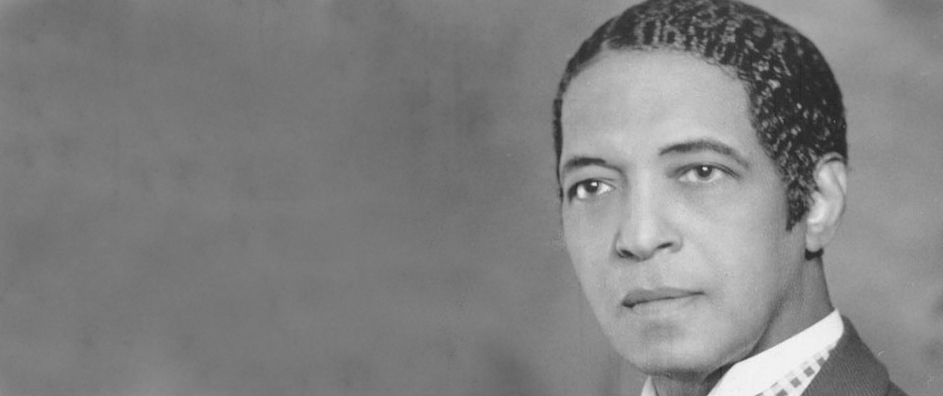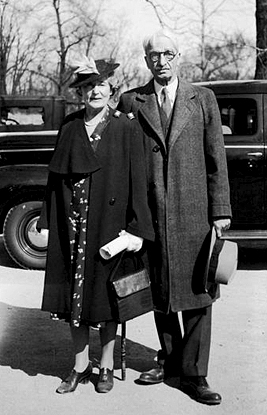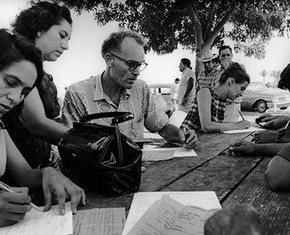The views expressed in our content reflect individual perspectives and do not represent the authoritative views of the Baha'i Faith.
In the last essay in this series (“Memphis Baha’is—Both Black & White—Finally Break Bread Together”), we recounted, as history, Doris McKay’s first-hand account of the integration of the Memphis Baha’i community during the Jim Crow era. Now let’s look at the remarkable accomplishments of the distinguished African American Baha’i, Professor George W. Henderson, and try to understand his legacy of positive progress in the face of enormous resistance in the pre-integration Jim Crow South.
In 1914, Mr. Henderson published a system of shorthand. Then he created a correspondence school in Knoxville, Tennessee (by renting a room in the Mayers Training school for 75 cents a week, and advertising Henderson Business College’s tuition rate of 50 cents a week). In 1916, he established Henderson Business College in Memphis, Tennessee, with its promise, “Where Dreams Come True,” and its mottos, “He Profits Most Who Serves Best” and “Accuracy, Speed, Neatness”—reflecting its high ethical standards. Henderson became known as the “World Famous Typist and Shorthand Wizard.” His success and his service to others became a national inspiration to other African Americans.
Henderson brought himself up by the bootstraps, from shining shoes to becoming one of the most educated African Americans of his generation:
Mr. Henderson, the king, has an interesting story. After years of shining shoes and doing odd jobs, he completed a course in business. Since that time, he has received 19 diplomas in various phases of business. With $2.20 and a determination to succeed, Mr. Henderson started his business college which to date is one of the largest in the nation, valued at more than $100,000.
– “Henderson Named King of Cotton Jubilee,” The Chicago Defender, May 18, 1940, p. 9.
It appears that Professor Henderson was an extraordinary teacher of the Baha’i Faith. Based on an archival document, there is evidence that Henderson formed a Baha’i community of some sixty individuals. This document commends Professor Henderson for his success in teaching—not only secretarial and other business skills—but teaching the Baha’i Faith to others as well:
A word from Brother Gregory [Louis G. Gregory] in Washington [DC] gives the glad news of the formation of an assembly at Memphis of some 60 souls. This is a cause of great joy to the friends here and will be of the utmost importance in the development of the South and their better understanding of the great universal principles of Baha’o’llah [Baha’u’llah]. The writer would dearly love at some future time to visit you in that favored spot and if there is any co-operation we can give from this end of the line, please call upon us. Please convey my Baha’i greetings to the friends of the assembly.
– Letter to George W. Henderson from Alfred Lunt, September 27, 1917. Alfred E. Lunt Papers. National Baha’i Archives, United States. Courtesy of Lewis V. Walker, Associate Archivist.
As of 1940 (and probably earlier), Henderson Business College also had an illustrious Dean, Dr. Miles Vandahurst Lynk (1871–1957), a son of former slaves. (See “School Gives Youth Chance: Henderson Business College Possesses High Reputation.” New York Amsterdam News (April 20, 1940), p. 10.) Prior to his service as Dean, Dr. Lynk had already distinguished himself in the field of medicine. On December 30, 1892, Dr. Lynk inaugurated the Medical and Surgical Observer, a professional medical journal that billed itself as “the Organ of the Colored Medical Profession of North American.” In October 1895, Dr. Lynk became one of the original founders of the National Medical Association, a powerful professional society of mainly Black physicians that still exists today.
On June 23, 1941, a Western Union cablegram was sent to “Mrs. Howard CL [Colby] Ives,” at her address in Little Rock, Arkansas. The message reads:
Mr. and Mrs. Howard Colby Ives
Dear Baha’i Sister
Our deepest sympathy in the passing of our beloved brother, Howard C. Ives, a great writer, author, lecturer and pioneer teacher in the [Baha’i] Cause. The beauty of his life will ever be an example of love, radiance and selfless service to humanity. Our sincere prayer,
[Signed] Fireside Study Group Henderson Business College.
This indicates the existence of a Baha’i teaching and study circle of African American Baha’is at the Henderson Business College. Dr. Henderson’s inspiring life was definitely, in the words of Abdu’l-Baha, “informed by the life of the Divine Spirit”:
An humble man without learning, but filled with the Holy Spirit, is more powerful than the most nobly-born profound scholar without that inspiration. He who is educated by the Divine Spirit can, in his time, lead others to receive the same Spirit. I pray for you that you may be informed by the life of the Divine Spirit, so that you may be the means of educating others. The life and morals of a spiritual man are, in themselves, an education to those who know him. – Abdu’l-Baha, Paris Talks, pp. 165–166.
How much more this applies to Professor Henderson, “received 19 diplomas in various phases of business.” Yet Professor Henderson was humble, in modest dignity.
The Pittsburgh Courier, a weekly newspaper with a national circulation, with the appealing headline, “From Shoe-shine Boy to College President,” told this story of the college and its remarkable founder:
The story of how George W. Henderson, with $2.20 and a resolute determination, an iron will and undaunted faith, created what has become the world’s largest business college for the colored youth in America, reads like that of Aladdin and his magic lamp. . .
The record of Prof. Henderson—holder of many diplomas from various schools and colleges, working his way upward from that of ‘shoe-shine boy’ to the professorship of a college—should be definite inspiration to the Negro youth of the nation as positive proof that ‘It can be done!’
‘Up from Slavery’ is one thing; but up from nothing is another. For after one reviews the difficulties overcome by this institution, and the rapidity with which it developed, he becomes mystified and marvels as he revels in the history of the achievements of Henderson Business College, under the mystic guidance of its president and founder, George W. Henderson, ‘The man who would not quit’.
– Louis G. Gregory, “Faith and the Man: The Remarkable Story of Henderson Business College, a Baha’i Enterprise.” The Baha’i World, Vol. 8, pp. 901–903.
A surprise result of the present writer’s research is the discovery of a newspaper photograph of one of the rooms in Henderson Business College, with this caption: “The institution also includes a spacious assembly for Baha’i students and their friends.” (This was actually a small chapel that Professor Henderson dedicated for Baha’i worship.) The news story, “Many Schools Helped By Scholarships,” was published on April 20, 1940 in the New York Amsterdam News on page 10. This story talks about a scholarship fund, donated by George W. Henderson in 1935, of $25,000, a tidy sum in those days. There other reports of Professor Henderson’s philanthropy as well.
Professor Henderson, the first Baha’i in Nashville in 1915 (having been taught the Baha’i Faith by Louis G. Gregory) defeated Jim Crow not by attacking it, but by overcoming it, by establishing a small, yet exemplary community that lived by the motto, “He Profits Most Who Serves Best.”

















Comments
Sign in or create an account
Continue with Googleor